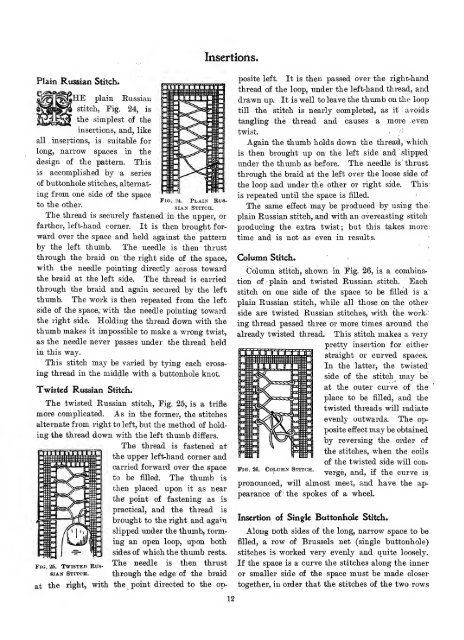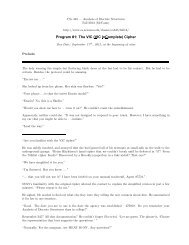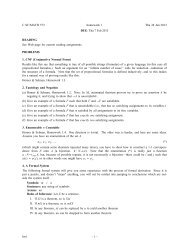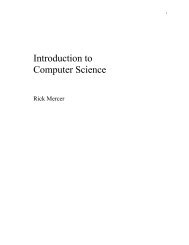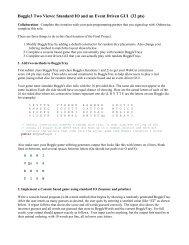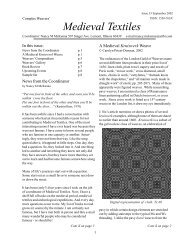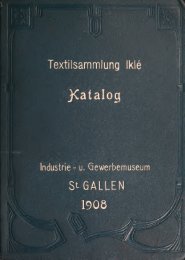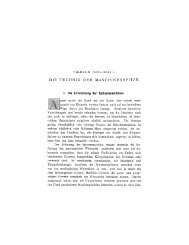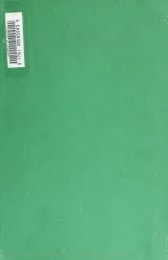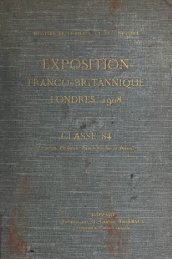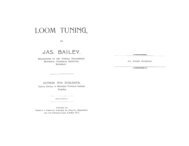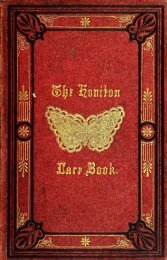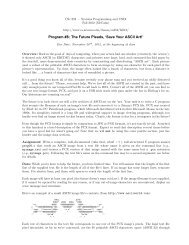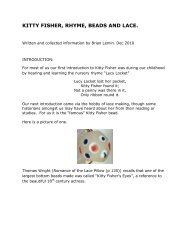The Priscilla Battenberg and point lace book; a collection of lace ...
The Priscilla Battenberg and point lace book; a collection of lace ...
The Priscilla Battenberg and point lace book; a collection of lace ...
Create successful ePaper yourself
Turn your PDF publications into a flip-book with our unique Google optimized e-Paper software.
Plain Russian Stitch.<br />
aHE plain Russian<br />
stitch, Fig. 24, is<br />
the simplest <strong>of</strong> the<br />
insertions, <strong>and</strong>, like<br />
all insertions, is suitable for<br />
long, narrow spaces in the<br />
design <strong>of</strong> the pattern. This<br />
is accomplished by a series<br />
<strong>of</strong> buttonhole stitches, alternat-<br />
ing from one side <strong>of</strong> the space<br />
, , , ., Fig. 24. Plaix Rusto<br />
the other.<br />
.^^^ s^^^^^<br />
<strong>The</strong> thread is securely fastened in the upper, or<br />
farther, left-h<strong>and</strong> corner. It is then brought forward<br />
over the space <strong>and</strong> held against the pattern<br />
by the left thumb. <strong>The</strong> needle is then thrust<br />
through the braid on the right side <strong>of</strong> the space,<br />
with the needle <strong>point</strong>ing directly across toward<br />
the braid at the left side. <strong>The</strong> thread is carried<br />
through the braid <strong>and</strong> again secured by the left<br />
thumb. <strong>The</strong> work is then repeated from the left<br />
side <strong>of</strong> the space, with the needle <strong>point</strong>ing toward<br />
the right side. Holding the thread down with the<br />
thumb makes it impossible to make a wrong twist,<br />
as the needle never passes under the thread held<br />
in this way.<br />
This stitch may be varied by tying each cross-<br />
ing thread in the middle with a buttbnhole knot.<br />
Twisted Russian Stitch.<br />
<strong>The</strong> twisted Eussian stitch, Fig. 25, is a trifle<br />
more complicated. As in the former, the stitches<br />
alternate from right to left, but the method <strong>of</strong> hold-<br />
ing the thread down with the left thumb differs.<br />
<strong>The</strong> thread is fastened at<br />
the upper left-h<strong>and</strong> corner <strong>and</strong><br />
carried forward over the space<br />
to be filled. <strong>The</strong> thumb is<br />
then p<strong>lace</strong>d upon it as near<br />
the <strong>point</strong> <strong>of</strong> fastening as is<br />
practical, <strong>and</strong> the thread is<br />
brought to the right <strong>and</strong> again,<br />
slipped under the thumb, form-<br />
ing an open loop, upon both<br />
sides <strong>of</strong> which the thumb rests.<br />
<strong>The</strong> needle is then thrust<br />
FIG. 26. TWISTED RussiAN<br />
Stitch. through the edge <strong>of</strong> the braid<br />
at the right, with the <strong>point</strong> directed to the op-<br />
Insertions.<br />
12<br />
posite left. It is then passed over the righT>-h<strong>and</strong><br />
thread <strong>of</strong> the loop, under the left-h<strong>and</strong> thread, <strong>and</strong><br />
drawn up. It is well to leave the thumb on the loop<br />
tni the stitch is nearly completed, as it avoids<br />
tangling the thread <strong>and</strong> causes a more even<br />
twist. ,•!<br />
Again the thumb holds down the thread, which<br />
is then brought up on the left side <strong>and</strong> slipped'<br />
<strong>The</strong> needle is 'thrust<br />
under the thumb as before. ^<br />
through the braid at the left over the loose side <strong>of</strong><br />
the loop <strong>and</strong> under the other or right side. This;<br />
i<br />
is repeated until the space is filled.<br />
<strong>The</strong> same effect may be produced by using the^<br />
plain Russian stitch, <strong>and</strong> with an overcasting stitch<br />
producing the extra twist; but this takes morei<br />
time <strong>and</strong> is not as even in results.<br />
Column Stitch.<br />
Column stitch, shown in Fig. 26, is a combinar<br />
tion <strong>of</strong> plain <strong>and</strong> twisted Russian stitch. Each<br />
stitch on one side <strong>of</strong> the space to be filled is a'<br />
plain Russian stitch, while all those on the other<br />
side are twisted Russian stitches, with the work-<br />
ing thread passed three or more times around the<br />
already twisted thread. This stitch makes a very<br />
Fig. 26. Column Stitch.<br />
pretty insertion for either<br />
straight or curved spaces.<br />
In the latter, the twisted'<br />
side <strong>of</strong> the stitch may be<br />
at the outer curve <strong>of</strong> the<br />
p<strong>lace</strong> to be filled, <strong>and</strong> the<br />
twisted threads will radiate<br />
evenly outwards. <strong>The</strong> op-<br />
posite effect may be obtained<br />
by reversing the order <strong>of</strong><br />
the stitches, when the coils<br />
<strong>of</strong> the twisted side will con-<br />
verge, <strong>and</strong>, if the curve is<br />
pronounced, will almost meet, <strong>and</strong> have the ap-<br />
pearance <strong>of</strong>' the spokes <strong>of</strong> a wheel.<br />
Insertion <strong>of</strong> Single Buttonhole Stitch.<br />
Along both sides <strong>of</strong> the long, narrow space to be<br />
filled, a row <strong>of</strong> Brussels net (single buttonhole)<br />
stitches is worked very evenly <strong>and</strong> quite loosely.<br />
If the space is a curve the stitches along the inner<br />
or smaller side <strong>of</strong> the space must be made closer<br />
together, in order that the stitches <strong>of</strong> the two rows


